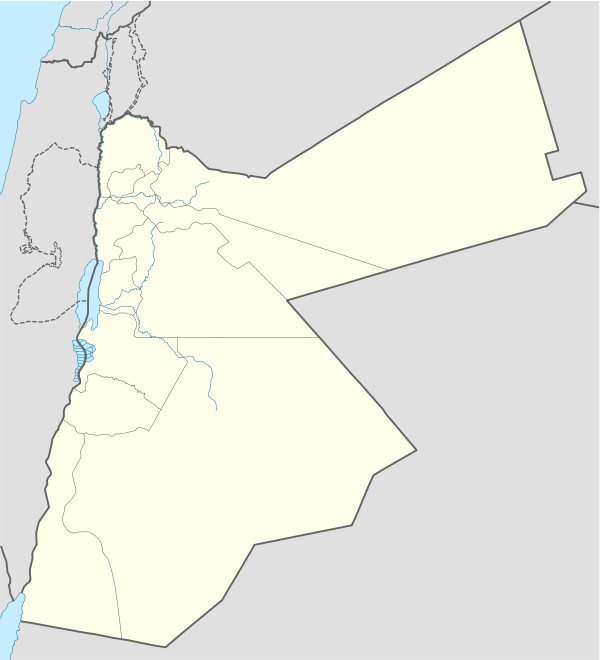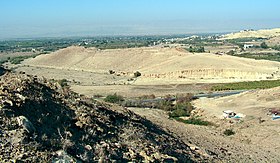Tall el-Hammam
Tell el-Hammam (also Tall al-Hammam) is an archaeological site in Jordan, in the eastern part of the lower Jordan Valley close to the mouth of the Jordan River. The site has substantial remains from the Chalcolithic, Early, Intermediate and Middle Bronze Age, and from Iron Age II. There are different attempts at identifying the site with a biblical city.
Tall al-Hammam | |
 Shown within Jordan | |
| Location | Jordan |
|---|---|
| Region | Amman Governorate |
| Coordinates | 31.8402°N 35.6737°E |
| History | |
| Cultures | Chalcolithic, Early Bronze Age, Middle Bronze Age, Late Bronze Age, Roman Age, Byzantine, Umayyad |

Possible identifications in different periods
- Early Bronze period – Beth-Haram ( בֵּית הָרָם, הָרָן)[1]
- Middle Bronze period – Steven Collins, co-director of the current excavation project and professor at two inerrantist US universities, presented the theory that Tell el-Hammam is identified with Sodom of the Hebrew Bible.[2]
- Late Bronze period – Beth-Haran.[3] The area around Tell el-Hammam, in the Late Bronze Age, is widely identified as Abel-Shittim (Hebrew meaning "Accacias of Mourning"), which is the location of Israel's encampment prior to entering the Promised Land (Numbers 25:1, Deuteronomy 34:9, Joshua 2:1, 3:1). Abel-Shittim became known in later periods as Abila in Peraea.[4]
- Iron Age – Beth-Haram (Solomonic Administrative city)[5]
- 1st Cent. BCE – Betharamtha (Βηθαραμθα)– (Herod the Great)[6]
- 1st Cent CE – Livias (Lat. Liviada Herod Agrippa 4 BC).[7] David E. Graves, a staff member of the inerrantist Associates for Biblical Research[8] believes that in the Roman, Byzantine, and Umayyad periods (165 BC–AD 750) the site was part of the city of Livias/Julias, an important city in Perea rebuilt by Herod Anitpas.[9]
- 1st Cent. CE – Julias (Herod Agrippa 14 AD)[10]
- Byzantine Period – Sodom (Severus the Bishop of Sodom attended the Council of Nicaea in 325 AD representing the ecclesiastical province of Arabia [provincia Arabia])[11]
Etymology
"Tell", sometimes spelled "tall", is the Arabic word for a mound created by successive layers of settlement debris, a term adopted into English for an archaeological mound. "Hammam" is Arabic for watering hole, bath/bathhouse or toilet/restroom.[12]
Archaeological work
Early surveys
A survey was done in 1975–76, which found some Middle Bronze Age pottery.[13]
In 1990, Kay Prag conducted a survey and some soundings.[14][2]
Excavation since 2005
Since 2005, the site has been excavated by a joint project of the unaccredited Trinity Southwest University (Albuquerque, New Mexico), the Creationist accredited Veritas International University's College of Archaeology & Biblical History (Santa Ana, California), and the Department of Antiquities of Jordan.[15][16]
Periods of settlement
Until 2016, the excavations have brought to light occupation layers from the Neolithic, Chalcolithic, the entire Bronze Age (Early, Intermediate, Middle and Late), then again from Iron Age 2, Hellenistic, Roman, Byzantine, and Islamic periods. However, by far the most substantial findings are from the Early Bronze Age (3600–2500 BCE), Intermediate Bronze Age (2500–1950 BCE), and Middle Bronze Age (after 1950 BCE).[17]
The site was occupied in the Chalcolithic (c. 4300-3600 BCE), Early Bronze Age (c. 3600–2500 BCE), Intermediate Bronze Age (2500–1950 BCE), Middle Bronze Age (c. 1950–1550 BCE), Iron Age 2–3 (c. 980–332 BCE) [18] and Hellenistic, Roman, Byzantine, and Umayyad periods (163 BCE–750 CE).[19] Like most sites in the Jordan Valley, it was vacant in the Late Bronze Age (c. 1550–1200 BCE). Only some Late Bronze pottery was discovered in a tomb.[20] The "Late Bronze Gap" (first named by Flanagan at Tall Nimrin) of c. 550 years is not unique to Tall al-Hammam but characteristic of many of the sites in the Jordan valley (Heb. kikkār) region, including Tall Iktanu, Tall Kefrein (al-Kefrayn), Tall Nimrin,[21] Tall el-Musṭāḥ, Tall Bleibel (Bulaybil), etc.[22]
Middle Bronze Age city
During the Middle Bronze Age, the city was protected by walls enclosing an area of 85 acres (34.4 hectares) and was divided into an upper and lower city, while the much larger general occupational area around the walled city covered 240 acres (97 hectares).[23][24]
Disputed identification with Sodom
Starting with the publication of his book Discovering the city of Sodom in 2013, Collins has been arguing that Tall el-Hammam is the site of the biblical city of Sodom.[2]
Inerrantist opposition
According to professor Eugene H. Merrill, himself a Biblical inerrantist, the identification of Tall al-Hammam with Sodom would require an unacceptable restructuring of the biblical chronology.[25][26][27]
Credentials
Current excavations are led by archaeologist Steven Collins, a professor at the College of Archaeology at the unaccredited Trinity Southwest University in Albuquerque, New Mexico, an institution that states that biblical scripture is the "divinely inspired representation of reality given by God to humankind, speaking with absolute authority in all matters upon which it touches".[28] Collins is also the Professor of Archaeology and Biblical History along with Professor of Biblical and Theological Studies at Veritas International University,[29] accredited by the Transnational Association of Christian Colleges and Schools which requires all accredited schools to have a statement of faith that affirms "the inerrancy and historicity of the Bible" and "the divine work of non-evolutionary creation including persons in God's image".[30]
See also
- Cities of the Ancient Near East
- List of minor biblical places
References
- Brussels E4: Egyptian Execration Text) Brussels E4 (Haram) is generally located at the later Beth Haram, northeast of the Dead Sea. Posener and Mazar identified Beth haram with Tell Ikanu (Adam Zertal Z"l and Shay Bar, The Manasseh Hill Country Survey Volume 4: From Nahal Bezeq to the Sartaba [Leiden: Brill, 2017], 80), however, Haram cannot be located at Tell Iktanu, as there are no Middle Bronze remains on the site, but as there is extensive Middle Bronze occupation at nearby Tell al-Hammam (Kay Prag, “Tell Iktanu and Tell Al-Hammam. Excavations in Jordan,” Manchester Archaeological Bulletin 7 (1992): 15–19), is a better candidate. Margreet L. Steiner and Ann E. Killebrew, The Oxford Handbook of the Archaeology of the Levant: C. 8000–332 BCE, Oxford Handbooks in Archaeology (Oxford: Oxford University Press, 2013), 47
- Collins, Steven; Scott, Latayne C. (2013). Discovering the City of Sodom: The Fascinating, True Account of the Discovery of the Old Testament's Most Infamous City. New York: Simon & Schuster. ISBN 978-1-4516-8438-4. Retrieved 13 April 2020.
- Numbers 32:36
- William M. Thomson, The Land and the Book: Lebanon, Damascus, and Beyond Jordan, vol. 3, 3 vols. (New York, NY: Harper & Brothers, 1886), 3:669; Nelson Glueck, Explorations in Eastern Palestine II, AASOR 15 (New Haven, CT: ASOR, 1935), 378; Nelson Glueck, “Some Ancient Towns in the Plains of Moab,” Bulletin of the American Schools of Oriental Research 91 (1943), 15; J. Maxwell Miller and Gene M. Tucker, The Book of Joshua, The Cambridge Bible Commentary of the English Bible (Cambridge, MI: Cambridge University Press, 1974), 199; R. K. Harrison, “Shittim,” ed. Edward M. Blaiklock, New International Dictionary of Biblical Archaeology (Grand Rapids, MI: Zondervan, 1983), 413; Rami G. Khouri, Antiquities of the Jordan Rift Valley (Manchester, MI: Solipsist, 1988), 76; Burton MacDonald, East of the Jordan: Territories and Sites of the Hebrew Scriptures, ed. Victor H. Matthews, ASOR Books 6 (Boston, MA: American Schools of Oriental Research, 2000), 90
- 1 Kings 4:7–19
- Josephus Antiquities 18.27
- Josephus Antiquities 20.29; Jewish War 2.168; 2.252; see also Theodosius Top. 19.1
- "Associates for Biblical Research – Dr. David Graves". biblearchaeology.org. Retrieved 10 February 2020.
- David E. Graves and D. Scott Stripling, “Re-Examination of the Location for the Ancient City of Livias,” Levant 43, no. 2 (2011): 178–200.
- Josephus Antiquities 18.27; 20.29; Jewish War 2.168; 2.252; 4.438
- Eusebius Onomasticon 26
- Gahrsa, Yamina; Mansouri, Fethi (2013). Survival Arabic: Phrasebook & Dictionary. Tuttle Publishing. ISBN 978-1-4629-1167-7. Retrieved 6 May 2020.
- Collins & Scott (2013), p. 96
- Prag, Kay (1991). "Preliminary Report on the Excavations at Tell Iktanu and Tell al-Hammam, Jordan, 1990". Levant (23:1): 55–66. doi:10.1179/lev.1991.23.1.55. Retrieved 2 May 2020.
- Steven Collins, Khalil Hamdan, and Gary A. Byers, "Tall al-Ḥammām: preliminary report on four seasons of excavation (2006–2009)", Annual of the Department of Antiquities, vol. 53, pp. 385–414, 2009
- Steven Collins, and H. al-Jarrah, "Tall al-Hammam season six, 2011: excavation, survey, interpretations and insights.", Annual of the Department of Antiquities of Jordan, vol. 55, pp. 581–606, 2011
- Banks, Rebecca (26 January 2017). "Endangered Archaeology as captured with the Aerial Archaeology in Jordan Project: September 2016 Season: Tell el-Hammam". Oxford: Endangered Archaeology in the Middle East & North Africa (EAMENA) – University of Oxford. Retrieved 3 May 2020.
- Steven Collins, Carroll M. Kobs, and Michael C. Luddeni, An Introduction to Tall Al-Hammam with Seven Seasons (2005–2011) of Ceramics and Eight Seasons (2005–2012) of Artifacts, vol. 1 (Winona Lake, IN: Eisenbrauns, 2015) ISBN 978-1575063690.
- Collins, Steven; Hussein, Aljarrah; Byers, Gary A.; Kobs, Carroll M.; Leslie, John; abu-Shmais, Adeib; Haroun, Jehad (2011). "Tall Al-Hammam Season Six, 2011: Excavation, Survey, Interpretations and Insights". Annual of the Department of Antiquities of Jordan. 55: 581.
- Collins, Steven; Hussein, Aljarrah; Byers, Gary A.; Kobs, Carroll M.; Leslie, John; abu-Shmais, Adeib; Haroun, Jehad (2011). "Tall Al-Hammam Season Six, 2011: Excavation, Survey, Interpretations and Insights". Annual of the Department of Antiquities of Jordan. 55: 597.
- Flanagan, James W.; McCreery, David W.; Yassine, Khair N. (1994). "Tell Nimrin: Preliminary Report on the 1993 Season". Annual of the Department of Antiquities of Jordan. 38: 207.
- Steven Collins, Khalil Hamdan, and Gary A. Byers, “Tall El-Hammam: Preliminary Report on Four Seasons of Excavation (2006–2009),” Annual of the Department of Antiquities of Jordan 53 (2009): 385–414
- Holden, Joseph M.; Geisler, Norman (2013). The Popular Handbook of Archaeology and the Bible. Harvest House Publishers. p. 216. ISBN 978-0-7369-4485-4. Retrieved 2 May 2020.
- Collins & Scott (2013), p. 157
- Merrill, Eugene H. "Texts, Talls, and Old Testament Chronology: Tall Hammam as a Case Study." Artifax 27, no. 4 (2012): 20–21.
- Bolen, Todd (2013-02-27). "Arguments Against Locating Sodom at Tall el-Hammam". Biblical Archaeology Society. Retrieved July 3, 2013.
- Contra Collins, Steven. Tall el-Hammam Is Still Sodom: Critical Data-Sets Cast Serious Doubt on E. H. Merrill’s Chronological Analysis" (PDF) Archived 2013-09-27 at the Wayback Machine, Biblical Research Bulletin 13, no. 1 (2013): 1–31.
- Doctrinal Position, Trinity Southwest University website, accessed March 10, 2012
- http://viu.ves.edu/graduate-post-graduate/
- "Accreditation Standards" (PDF). Transnational Association of Christian Colleges and Schools. 2009. Retrieved 2008-12-26. page 80, also see: "Biblical Creation. Special creation of the existing space-time universe and all its basic systems and kinds of organisms in the six literal days of the creation week." on page 81